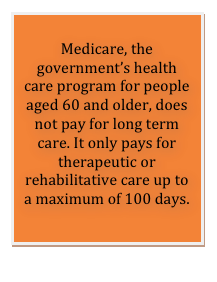A lot of us carefully plan for our retirement – invest in mutual funds, contribute to 401k and pay mortgages – but even the most well thought of plan can be threatened if it does not include preparations for long term care.
 Long term care involves a wide variety of services for people who need assistance in performing basic activities of daily living such as dressing, eating, bathing, toileting and ambulating. This kind of care will become necessary to at least 70% of people aged 65 and older according to the US Department of Health and Human Services. Planning how to pay for it is one of the long term care basics that you must include in your retirement planning.
Long term care involves a wide variety of services for people who need assistance in performing basic activities of daily living such as dressing, eating, bathing, toileting and ambulating. This kind of care will become necessary to at least 70% of people aged 65 and older according to the US Department of Health and Human Services. Planning how to pay for it is one of the long term care basics that you must include in your retirement planning.The following are some of the financing options for this kind of care.
1. Introduced in the mid-1970s, long term care insurance is seen as the most cost effective source of financing for long term care. By paying pre-determined premiums, you can protect your family from the financial burden of having to pay for your care. To encourage people buy LTC coverage, the government provides tax-incentives to owners of qualified policies.
2. If you meet the poverty criteria of your state, Medicaid can help pay for your care but in the event of your death, it will try to recover its expenses by forcing a sale on whatever is left on your estate.
3. Your life insurance can help pay for your care if you have the accelerated death benefits rider. This rider allows you to make a cash advance on your death
benefits. Whatever amount you get will be deducted on the amount your heir will receive when you die.
You can also sell your life insurance through life settlements. In life settlements, an investor pays a lump sum amount in exchange for the right to claim your death benefits.
4. If you’re at least 62 years of age, you can take a reverse mortgage in your home. This type of loan does not require monthly re-payments as long as the home you loaned remains as your primary place of residence.
